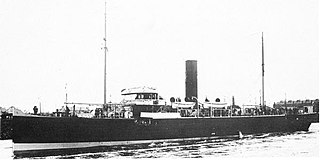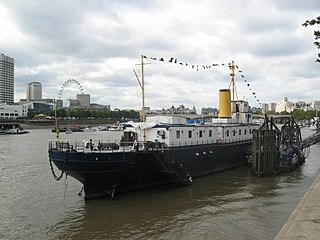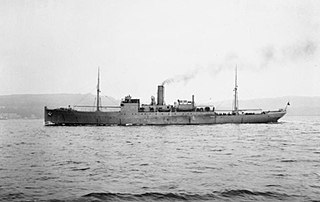
Q-ships, also known as Q-boats, decoy vessels, special service ships, or mystery ships, were heavily armed merchant ships with concealed weaponry, designed to lure submarines into making surface attacks. This gave Q-ships the chance to open fire and sink them. The use of Q-ships contributed to the abandonment of cruiser rules restricting attacks on unarmed merchant ships and to the shift to unrestricted submarine warfare in the 20th century.

Steam frigates and the smaller steam corvettes, steam sloops, steam gunboats and steam schooners, were steam-powered warships that were not meant to stand in the line of battle. The first such ships were paddle steamers. Later on the invention of screw propulsion enabled construction of screw-powered versions of the traditional frigates, corvettes, sloops and gunboats.

HMS Black Swan, was the name ship of the Black Swan-class sloops of the Royal Navy. This class was admired for its sea-going qualities.
Five ships and one shore establishment of the Royal Navy have been named HMS President, after the office of president meaning "one who presides over an assembly". In the case of the first two British ships, the name may have applied to the Lord President of the Privy Council.

HMS Kingfisher was a Doterel-class screw sloop of the Royal Navy. She was built at Sheerness Dockyard and launched on 16 December 1879. She conducted anti-slavery work in the East Indies in the late 1880s before being re-roled as a training cruiser, being renamed HMS Lark on 10 November 1892, and then HMS Cruizer on 18 May 1893. She was sold in 1919.

The twenty-eight Anchusa-class sloops were built under the Emergency War Programme for the Royal Navy in World War I as the final part of the larger "Flower class", which were also referred to as the "Cabbage class", or "Herbaceous Borders".

HMS President is a retired Flower-class Q-ship that was launched in 1918. She was renamed HMS President in 1922 and moored permanently on the Thames as a Royal Navy Reserve drill ship. In 1982 she was sold to private owners and, having changed hands twice, served as a venue for conferences and functions as well as the offices for a number of media companies. She has been moved to Chatham on the Medway in Kent since 2016, but is due to return to the capital. She had the suffix "(1918)" added to her name in order to distinguish her from HMS President, the Royal Naval Reserve base in St Katharine Docks. She is one of the last three surviving Royal Navy warships of the First World War. She is also the sole representative of the first type of purpose built anti-submarine vessels, and is the ancestor of World War II convoy escort sloops, which evolved into modern anti-submarine frigates.

HMSGannet is a Royal Navy Doterel-class screw sloop-of-war launched on 31 August 1878. It became a training ship in the Thames in 1903, and was then loaned as a training ship for boys in the Hamble from 1913. It was restored in 1987 and is now part of the UK's National Historic Fleet.

HMS Aberdare was the name ship of her sub-class of the Hunt-class minesweepers built for the Royal Navy during World War I. She survived both World Wars to be scrapped in 1947.

The Flower class comprised five sub-classes of sloops built under the Emergency War Programme for the Royal Navy during World War I, all of which were named after various flowers. They were popularly known as the "herbaceous borders", in humorous reference to a well-known adage about the Royal Navy, as well as to a type of garden arrangement popular in the United Kingdom.

HMS Despatch was a Danae-class light cruiser built for the Royal Navy during World War I. She was part of the Delhi sub-class of the Danae class.

HMS Eaglet is a Royal Navy Reserve unit based in Liverpool. She is the main occupant of the Royal Navy Regional Headquarters in Liverpool, Merseyside. The base is also the home to a number of units, including:Royal Marines Reserve Merseyside, Naval Regional Command Northern England, Liverpool URNU, HMS Biter, HMS Charger, Sea Cadet Corps, and the Liverpool Royal Navy and Royal Marines Careers Office.

HMS President is a "stone frigate", or shore establishment of the Royal Naval Reserve, based on the northern bank of the River Thames near Tower Bridge in Wapping and is in the London Borough of Tower Hamlets.

HMS Juno was a Royal Navy 32-gun Amazon-class fifth rate. This frigate served during the American War of Independence, and the French Revolutionary and Napoleonic Wars.

HMS Dido was an Eclipse-class protected cruiser built for the Royal Navy in the mid-1890s.

HMS Peacock was a modified Black Swan-class sloop of the Royal Navy. She was built for service as a convoy escort during the Second World War, serving in the arctic and Atlantic convoys. After the Second World War she saw service in the Mediterranean. She was scrapped in 1958.
SS Ardena was a minesweeper and escort vessel built as an Azalea-class sloop minesweeper for the British Royal Navy with the name HMS Peony in 1915.

HMS Coreopsis was an Anchusa-class sloop and Q-ship of the Royal Navy, built at the yards of Barclay Curle on Clydeside and launched on 15 September 1917. Employed as a decoy ship with concealed armament, she served with the Grand Fleet or in the Mediterranean operating from Gibraltar under the false names Beardsley and Bigott. After the end of the First World War, she was laid up before being sold for breaking on 6 September 1922, but did not arrive at Thos. W. Ward's yard in Preston, Lancashire until 5 May 1924.

HMS Shoreham was the lead ship of the Shoreham-class of sloops built for the British Royal Navy. Completed in 1931, Shoreham served pre-war in the Persian Gulf. In the Second World War she served in the Gulf and Red Sea, the Mediterranean and the Indian Ocean. She survived the war and was sold for commercial use in 1946 and was scrapped in 1950.
HMS Cornflower was an Arabis-class sloop of the Royal Navy and from 1933 the Hong Kong Naval Volunteer Force (HKNVR).

















